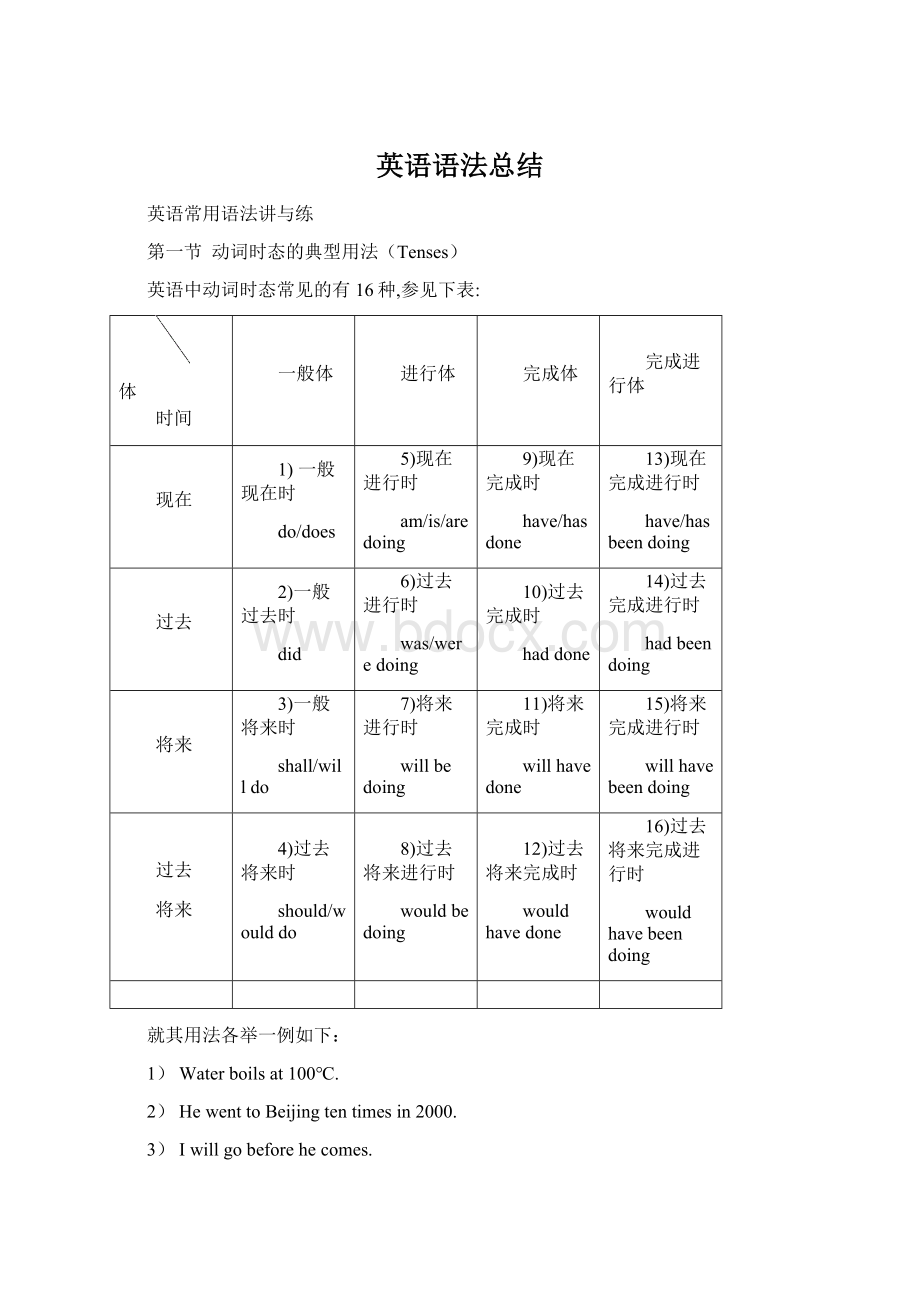英语语法总结.docx
《英语语法总结.docx》由会员分享,可在线阅读,更多相关《英语语法总结.docx(34页珍藏版)》请在冰豆网上搜索。

英语语法总结
英语常用语法讲与练
第一节动词时态的典型用法(Tenses)
英语中动词时态常见的有16种,参见下表:
体
时间
一般体
进行体
完成体
完成进行体
现在
1)一般现在时
do/does
5)现在进行时
am/is/aredoing
9)现在完成时
have/hasdone
13)现在完成进行时
have/hasbeendoing
过去
2)一般过去时
did
6)过去进行时
was/weredoing
10)过去完成时
haddone
14)过去完成进行时
hadbeendoing
将来
3)一般将来时
shall/willdo
7)将来进行时
willbedoing
11)将来完成时
willhavedone
15)将来完成进行时
willhavebeendoing
过去
将来
4)过去将来时
should/woulddo
8)过去将来进行时
wouldbedoing
12)过去将来完成时
wouldhavedone
16)过去将来完成进行时
wouldhavebeendoing
就其用法各举一例如下:
1)Waterboilsat100℃.
2)HewenttoBeijingtentimesin2000.
3)Iwillgobeforehecomes.
4)ShewouldnotleaveuntilIreturned.
5)Iwillthinkitoverwhileyouarecollectingmaterials.
6)Shetoldmetowakehimupifhewassleeping.
7)IwillbesittinginfrontoftheTVsetthistimetomorrow.
8)HepromisedthathewouldbelookingaftermydogwhenIlefthere.
9)Wehaven’theardfromeachotherforthreeyears.
10)JanehadlearnedChinesebeforeshecametoChina.
11)Bytheendofthisterm,Iwillhavetaughtathiscollegefor10years.
12)YesterdayMr.Lisaidhewouldhavebeeninthiscollegefor10yearsbytheendoftheterm.
13)Hehasbeenwritingletterssincehismorning.
14)Afterdrivingforalongtime,shesuddenlyrealizedthatshehadbeendrivinginthewrongdirectionalltheafternoon.
15)Bythetimethesunsets,theywillhavebeenworkingonthefarmfor6hours.
16)YesterdayMr.Lisaidhewouldhavebeenteachinginthiscollegefor10yearsbytheendoftheterm.
1一般现在时
(thesimplepresenttense)
1)经常发生或反复发生的动作:
Hesmokesalot.
Howoftendoyougoswimming?
2)现时的情况与状态:
Iknowyouarebusy.
Howdoyoulikethiscity?
3)永恒的真理:
Summerfollowsspring.
Thesunrisesintheeast.
ⅰ还常常用于静态动词(表示一种状态的动词),代替使用进行时态:
如mean,seem,hate,surprise,guess,feel,hope,sound,need,know,understand,wish等.
ⅱ表示现在时刻发生的动作:
运动解说,演示说明,动作描述,剧情介绍,舞台动作说明,用来指引道路,图片说明.
ⅲ表示将来情况:
表示规定,时间表,计划或安排要发生的事情,这时有一个表示未来时间的状语,只限于少数动词,如arrive,be,begin,close,come,depart,dine,end,finish,go,leave,open,return,sail,start,stop.另外在由if,unless,evenif,when,after,before,assoonas,aslongas,as等引导的时间或条件从句中,一般只能用一般现在时表示将来的动作.
Turnoffthelightsbeforeyouleave.
Ifwehurry,wemaycatchthebus.
ⅳ表示过去动作的用法,只限于少量动词,如hear,say,tell等.
Yes,youanswerquitewell.
Oh,Iforgetwhereshelives.
此外,故事性读物中戏剧性的描绘,报纸标题中,小说章节的题目中,引用书面材料时.
ⅴ常常和一般现在时一道用的副词和状语.如now,today,often,usually,normally,generally,weekly,seldom,never,ever,atthemoment,onceamonth,nowandthen等.
2.现在进行时
(thepresentcontinuoustense)
1)表示现在正在进行的动作:
Theyaretalking;theyaren’tworking.
Myheadisaching.
2)表示现在这个阶段正在发生的事(但说话的一刻不一定在进行):
Areyoustayingatthehotel?
What’syourdaughterdoingthesedays?
ⅰ在进行时用于表示将来动作的用法:
如果主语是表示事物的名词作主语,动词都以一般现在时表示将来动作,如果以人为主语,表示是安排要进行的动作,一般用现在进行时.
ⅱ另外,还有begoingto这个结构经常用来表示未来的情况,一是表示准备,打算干什么,二是表示即将发生的情况.
I’mgoingtobuysomecassettetapes.
Ohdear!
It’stentonine.I’mgoingtobelate.
ⅲ有在时间或条件从句中,有时会用现在进行时表示未来动作.
Whileyouaretravelingthere,youmustvisittheseplaces.
ⅳ表示经常性动作的用法,这时都表现某类情绪.这类句子常带有always,constantly,forever,continually,perpetually这类副词.
Sheisforevercomplainingaboutherjob.
Youarealwaysleavingyourclothesonthefloor!
ⅴ至有一些静态动词也用于现在进行时.
I’mhopingyouwillcome.
ⅵ除了以上这些,还可用于戏剧式的描绘,解说词,暂时的情况,新闻标题等.
3.现在完成时
(thepresentperfecttense)
现在完成时是一个把过去和现在联系起来的时态.谈的都是已经发生的事,但和现在都有某种关系,就是指从过去某时到现时,某事已完成或已经发生.如:
I’velostmypassport.
Hashefoundhercarkey?
这个时态经常和just,already,yet,ever,always,before,sofar,for,since,howlong等词连用.
I’vealreadypostedyourletters.
有时表示从过去到现在这一段时间内发生的事.
I’vebeentheretwicethisyear.
有时表示持续到现在的状态.
I’vewaitedaweekforyouranswer.
havegoneto/havebeento和time连用的情况havegotto=haveto
4.现在完成进行时
(thepresentperfectcontinuoustense)
现在完成进行时表示一个由过去某时起一直持续的动作,这动作可能刚刚停止,也可能正在进行.如:
Thegroundiswet.Ithasbeenraining.
You’reoutofbreath.Haveyoubeenrunning?
用这个时态经常有一个表示现在之前这一段时间的状语,如allday,forsomeyears,since,recently,howlong,long,all等.
有时表示在持续的一段时间中动作的多次重复(而动作不一定在持续):
JimhasbeenphoningJerryeverynightforthepastweek.
第二节动词语态的典型用法(Voices)
英语语态有两种:
主动语态(activevoice)和被动语态(passivevoice)。
一般来说,被动语态的主语是动词的承受者,即动作的对象。
被动语态的形式是:
be+过去分词。
常用的被动语态构成形式如下:
一般时态
进行时态
完成时态
现在
1)am/is/aredone
5)am/is/arebeingdone
7)have/hasbeendone
过去
2)was/weredone
6)was/werebeingdone
8)hadbeendone
将来
3)shall/willbedone
_________
9)shall/willhavebeen
done
过去
将来
4)should/wouldbedone
_________
10)should/wouldhavebeendone
举例:
1)Acarispoweredbygasoline.
2)Alleyeswereturneduponhim.
3)Otherprocesseswillbediscussedbriefly.
4)Themanagersaidthatthematterwouldbediscussedatthenextmeeting.
5)Whoisbeingoperatedon?
6)Atthattime,Ididn’tknowwhowasbeingope